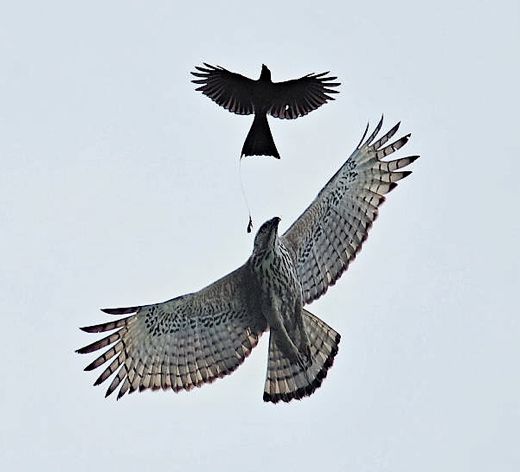KC Tsang was at Bukit Brown cemetery on the morning of 3rd April 2008 observing swifts and swallows. His mission was to photograph these birds and try develop a field photographic identification guide (see 1, 2 and 3).
While at Bukit Brown, he noticed an approaching raptor. As the bird flew nearer, he recognised it as a Changeable Hawk Eagle (Spizaetus cirrhatus).
His full attention was drawn towards it by the cacophony of loud bird cries. The eagle was being pursued by a pair of Greater Racket-tailed Drongo (Dicrurus paradisus) and all three birds were calling excitedly.
KC managed to capture the magic moment when the eagle was making a powerful downward flap of its huge pair of wings to gain altitude. The lead drongo was way behind and below it, its pair of racket-tails trailing like a pair of black blobs (above).
As the lead drongo approached nearer (above), the eagle suddenly maneuvered around. Instead of being the pursuer, the lead drongo became the pursued. The eagle came very near to the drongo and could very well have grabbed it (below). Maybe it was not hungry then. It merely flew away after scattering the panicking pair of drongos, satisfied with just getting rid of the irritating mobbers.
It should be noted that the Changeable Hawk Eagle is an expert aerial acrobat, capable of zooming up vertically and nose diving, or stooping at lightning speed, even doing a complete looping-the-loop turn in the air.
The Greater Racket-tailed Drongo has a reputation of being aggressive and fearless. It will attack much larger birds, including raptors, especially when they are brooding chicks. These birds have been known to also attack people walking near or below an active nest. Goh Si Guim was once attacked in the Bukit Timah Nature Reserve and live to tell his tale.
Drongos also indulge in kleptoparasitism, snatching food from smaller birds as well as mammal species. They have been known to follow groups of foraging babblers. When any of these babblers capture a large prey, the drongo may give an alarm call frightening the foraging individual. When the latter drops the food item, the drongo swoops down and claims it. In this incident of the eagle and the drongos, it was not about kleptoparasitism, as the former was not clutching any prey. Besides, the eagle is a much bigger bird than the drongo.












5 Responses
Amazing pictures and account. Thanks for sharing!
congrats again, KC! amazing action shots! I would have been too thrilled at the sight to remember to take any photos!
The article is very well written too – heart-stopping!
Joyce
Palo Alto
California
I was reminded of this post when I was at the Botanic Gardens yesterday.
I was watching a Brahminy kite resting in a palm tree when a greater racquet-tailed drongo started mobbing it. The raptor was eventually driven from its perch, with the drongo in close pursuit. In mid-flight, the kite turned over and brandished its talons at the drongo, which flinched for a moment, then renewed its mobbing. The two birds eventually vanished in the distance, with the drongo still chasing the kite.
Good to have your observation, Hai-Ren. For the records.
And many other Birds nest with in their range to afford the protection offered by the Drongo